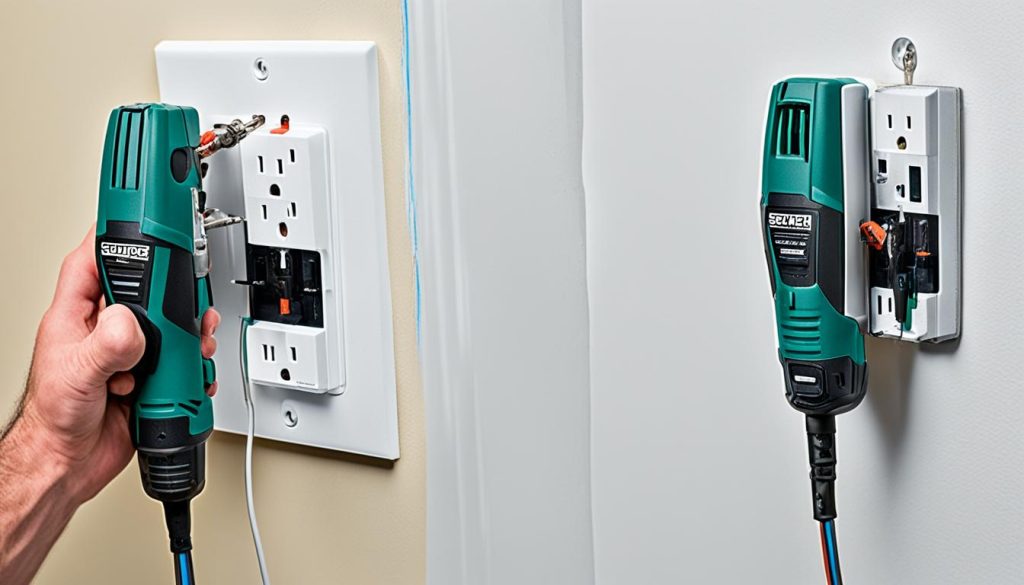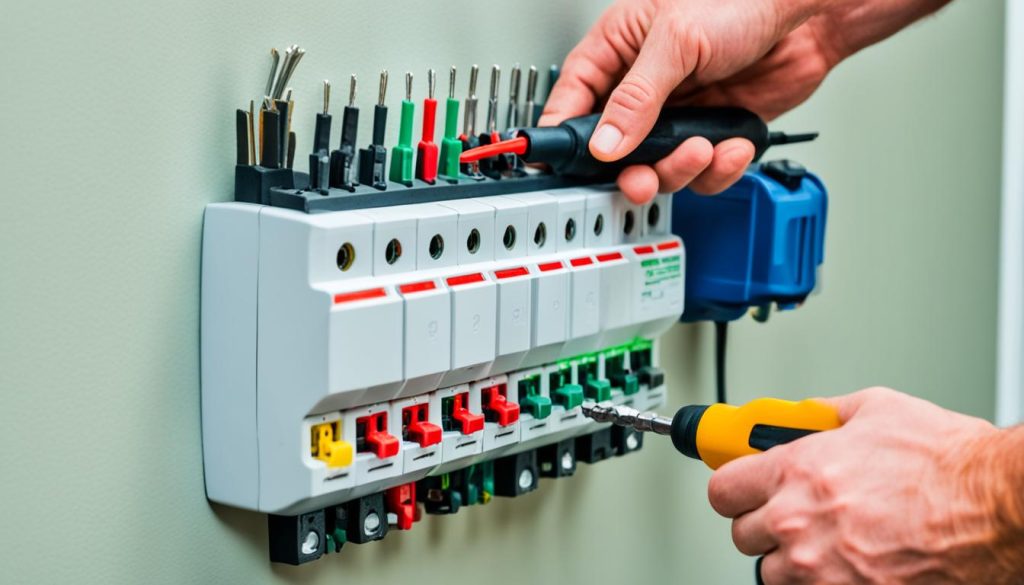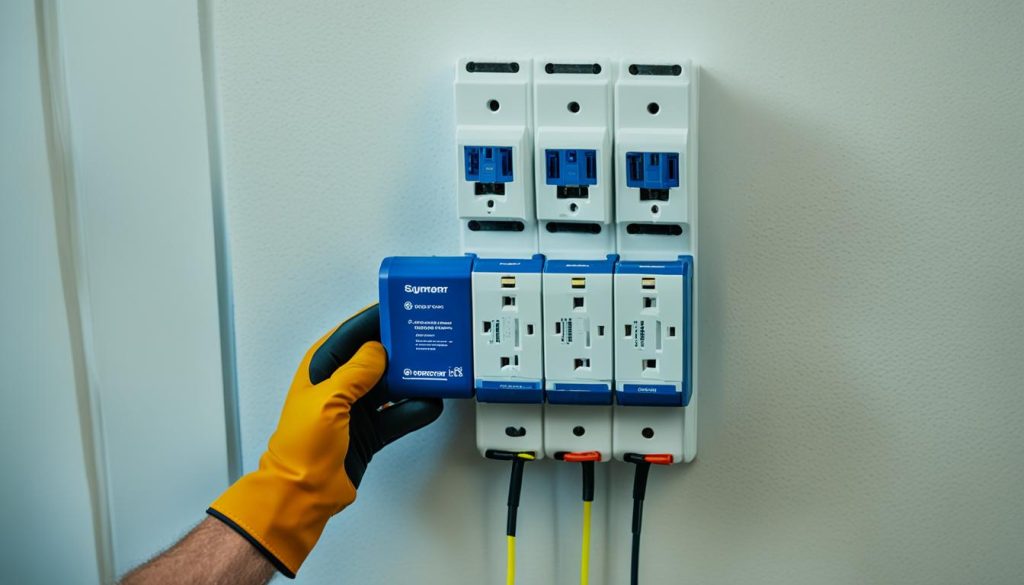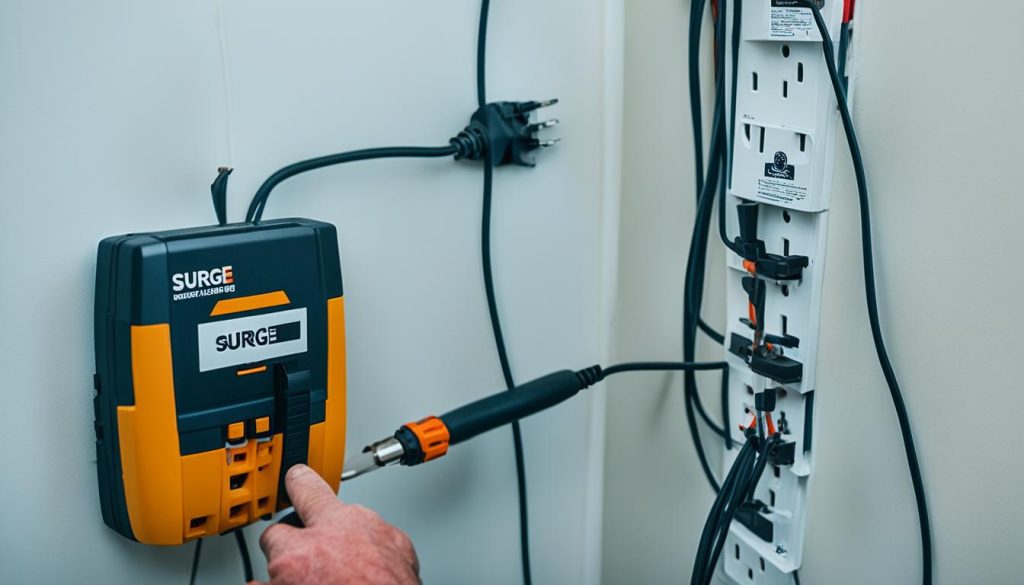Voltage fluctuations, surges, and spikes can damage your electronics and degrade their performance. Mounting a surge protector on your wall can help protect your computers, printers, hard drives, and other equipment from damage. Belkin Surge Protectors are designed for wall mounting and have two mounting holes on the back. Follow the steps below for a simple guide on how to mount a surge protector on your wall.
Key Takeaways:
- Mounting a surge protector on the wall helps protect your electronics from voltage fluctuations and surges.
- Belkin Surge Protectors are designed for wall mounting and have two mounting holes on the back.
- Follow the step-by-step guide for a simple and secure installation.
- Consider safety precautions such as turning off the power and not overloading the surge protector.
- If wall mounting is not preferred, alternative options like adhesive hooks or cable clips can be used.
Why Mount a Surge Protector on the Wall?
Mounting a surge protector on the wall offers several advantages. By keeping cables organized and securely connected, it helps prevent accidental disconnections and ensures uninterrupted power supply to your electronic devices. Moreover, wall mounting saves valuable desk or floor space by keeping the surge protector off the surface. This not only creates a cleaner and more organized workspace but also reduces the risk of tripping over cables. Additionally, wall mounting keeps the surge protector and connected devices out of reach of children and pets, minimizing the risk of damage or electric shock. Lastly, mounting the surge protector on the wall provides a professional aesthetic appeal, giving your workspace a neat and tidy look.
When it comes to protecting your electronics and maintaining a clean and organized workspace, wall mounting a surge protector is the best way to go.
Steps to Mount a Surge Protector on the Wall
Mounting a surge protector on the wall is a straightforward process that can help protect your electronics and keep your workspace organized. Follow these step-by-step instructions for mounting a surge protector on the wall:
1.
Choose the Location:
Decide where you want to mount the surge protector on the wall. Ideally, it should be close to the power outlet and within reach of your devices’ cables.
2.
Prepare the Tools:
Gather all the necessary tools and materials, including a drill, screws suitable for your wall type (wood screws or wall anchors), a screwdriver or drill bit, a level, a pencil or marker, and, of course, the surge protector with mounting holes on the back.
3.
Mark the Mounting Holes:
Hold the surge protector against the wall in the desired location and use a pencil or marker to mark the mounting holes. Make sure the surge protector is level.
4.
Drill the Holes:
Using the marked spots as a guide, drill pilot holes into the wall to accommodate the screws or wall anchors. Take care not to drill too deep or damage any electrical wiring behind the wall.
5.
Attach the Surge Protector:
Align the mounting holes on the surge protector with the pilot holes in the wall. Insert the screws through the mounting holes and tighten them securely. If using wall anchors, follow the instructions provided with the anchors to ensure proper installation.
6.
Verify Stability and Levelness:
After securing the surge protector to the wall, check that it is stable and level. Adjust as necessary by tightening or loosening the screws.
7.
Connect Devices and Route Cables:
Once the surge protector is securely mounted on the wall, connect your devices to the surge protector and route the cables neatly to prevent tangling or tripping hazards.

By following these step-by-step instructions, you can successfully mount a surge protector on the wall and provide enhanced protection for your valuable electronics. Enjoy a clutter-free workspace and peace of mind knowing that your devices are safeguarded against power surges and voltage fluctuations.
Recommended Tools and Materials
To mount a surge protector on the wall, you will need the following tools and materials:
| Tool/Material |
|---|
| Drill |
| Screws suitable for mounting on your type of wall (wood screws for wooden walls, wall anchors for drywall) |
| Screwdriver or drill bit (depending on the type of screws) |
| Level |
| Pencil or marker |
| Surge protector with mounting holes on the back |
Having these tools and materials ready will ensure a smooth and successful surge protector wall installation. Now, let’s move on to the next section to learn the steps for mounting a surge protector on the wall.

Tips for a Neat and Secure Installation
When mounting your surge protector on the wall, it’s important to ensure a neat and secure installation. Follow these tips to achieve the best results:
1. Choose the Right Location
Before mounting your surge protector, carefully select the ideal location on the wall. Consider accessibility, cable length, and proximity to your electronics. A central location will allow for easy cable management and minimize the risk of accidental disconnections.
2. Use Proper Mounting Hardware
Ensure that you use the appropriate mounting hardware for your specific wall type. For wooden walls, use wood screws, and for drywall, use wall anchors. This will provide a secure attachment and prevent the surge protector from falling or becoming dislodged.
3. Check for Level and Stability
Before finalizing the mounting, use a level to ensure that the surge protector is straight. This will not only enhance the aesthetic appeal but also prevent potential strain on the cables. Check the stability of the mount by gently tugging on the surge protector to ensure it is firmly secured.
4. Organize Cables
To achieve a clean and organized look, properly manage the cables connected to your surge protector. Use cable clips or ties to secure and route the cables along the wall to prevent them from dangling or tangling. This will enhance the overall appearance and make maintenance easier.
| Tip | Image |
|---|---|
| Use cable clips to secure and organize cables |  |
5. Consider Child and Pet Safety
If you have children or pets at home, it’s crucial to mount the surge protector out of their reach. Select a height that prevents accidental tampering or damage to the devices. This will help ensure the safety of both your little ones and your valuable electronics.
Pro Tip: Consider using a surge protector with built-in child safety features, such as tamper-resistant outlets or protective covers.
6. Regularly Inspect and Maintain
After mounting the surge protector, periodically inspect the installation to ensure its stability and functionality. Check for any loose screws or cables and make any necessary adjustments or repairs. This will help maintain the integrity of the installation and prolong the lifespan of your surge protector and connected devices.
By following these tips, you can securely mount your surge protector on the wall, ensuring a clean and organized installation. Not only will this protect your electronics from power surges, but it will also enhance the functionality and appearance of your workspace. Enjoy the benefits of a tidy and efficient setup while safeguarding your valuable equipment.
Safety Precautions
When it comes to surge protector wall installation, taking the necessary safety precautions is crucial. Follow these guidelines to ensure a safe and successful installation:
- Turn off the power to the area where you will be working. This will help prevent any potential electrical accidents or shocks.
- Ensure that the surge protector you are using is compatible with your electrical system and meets the necessary safety standards. Checking the manufacturer’s instructions and specifications can help you make sure you have the right surge protector for your setup.
- Do not overload the surge protector with too many devices. Overloading can cause the surge protector to overheat, which may lead to a fire hazard. Make sure to distribute your devices evenly across multiple surge protectors if needed.
- Keep the surge protector away from water sources. Water and electricity do not mix well and can result in electrical shock if there is contact. Place the surge protector in a dry location to avoid any potential accidents.
- If you are unsure about any aspect of the installation process or have concerns about your electrical system, it’s advisable to consult a professional electrician. They can provide expert advice and ensure a safe installation.
By following these safety precautions, you can minimize the risks associated with surge protector wall installation and create a safer environment for your electronic devices.

Note: The image above is for illustrative purposes only and does not depict the exact surge protector wall installation process.
Alternatives to Wall Mounting
If you prefer not to mount a surge protector on the wall, there are alternative options available. Here are a few suggestions:
- Adhesive Hooks: You can use adhesive hooks to secure the surge protector to the back of your desk or the side of a piece of furniture. This keeps it within reach while minimizing cables on your workstation.
- Cable Clips: Another option is to use cable clips to hold the surge protector in place. These clips can be attached to the edge of your desk or the back of a cabinet, providing a tidy cable management solution.
- Velcro Strips or Cable Ties: For a more flexible setup, you can use Velcro strips or cable ties to keep the surge protector in place. These reusable fasteners allow you to secure the surge protector to different surfaces, ensuring stability.
Please note that these alternatives may not offer the same level of stability and organization as wall mounting. Consider your specific needs and workspace setup when deciding which option is most suitable for you.
Conclusion
Mounting a surge protector on the wall is a simple and effective solution for safeguarding your valuable electronics from voltage fluctuations and surges. Following the step-by-step guide outlined in this article, you can easily achieve a secure and organized installation. By taking the necessary safety precautions, such as turning off the power and ensuring compatibility, you can mitigate any potential risks and create a safe workspace.
Whether you choose to wall mount the surge protector or explore alternative options like adhesive hooks or cable clips, the ultimate goal is to protect your devices and maintain a clean and clutter-free environment. Not only does wall mounting provide added protection for your electronics, it also helps to keep cables organized and prevents accidental disconnections, saving valuable space on your desk or floor.
Remember to use suitable tools and materials, such as a drill, screws, level, and a surge protector with mounting holes, to ensure a neat and secure installation. If you have any doubts or concerns about the process, it’s always wise to consult a professional electrician for guidance.
FAQ
Why should I mount a surge protector on the wall?
Mounting a surge protector on the wall helps protect your electronics from voltage fluctuations, surges, and spikes. It also keeps cables organized, saves space on your desk or floor, keeps the surge protector out of reach of children and pets, and provides a cleaner look.
How do I mount a surge protector on the wall?
To mount a surge protector on the wall, you will need a drill, suitable screws for your wall type, a screwdriver, a level, and the surge protector with mounting holes on the back. Follow the step-by-step guide provided in this article for detailed instructions.
What tools and materials do I need to mount a surge protector on the wall?
You will need a drill, screws suitable for mounting on your type of wall (wood screws for wooden walls, wall anchors for drywall), a screwdriver or drill bit, a level, a pencil or marker, and a surge protector with mounting holes on the back.
Are there any tips for ensuring a neat and secure installation of the surge protector?
Yes, here are some tips: turn off the power to the area where you will be working, ensure compatibility with your electrical system and safety standards, avoid overloading the surge protector, keep it away from water sources, and consult a professional electrician if needed.
What safety precautions should I take when mounting a surge protector on the wall?
Ensure that the power is turned off, use a surge protector compatible with your electrical system, avoid overloading the surge protector, and keep it away from water sources to prevent electrical shock.
Are there alternatives to wall mounting a surge protector?
Yes, you can use adhesive hooks, cable clips, Velcro strips, or cable ties to secure the surge protector to the back of your desk or the side of a piece of furniture. However, these alternatives may not provide the same level of stability and organization as wall mounting.
How can I protect my electronics without mounting a surge protector on the wall?
If you prefer not to mount a surge protector on the wall, you can use alternative options such as adhesive hooks, cable clips, Velcro strips, or cable ties to secure the surge protector to your desk or furniture.


